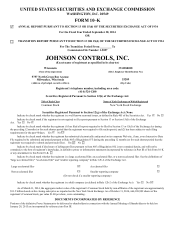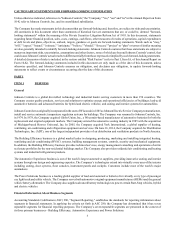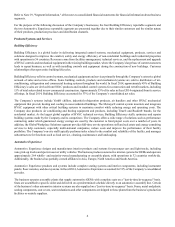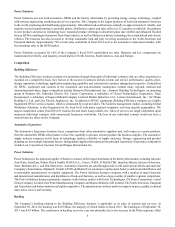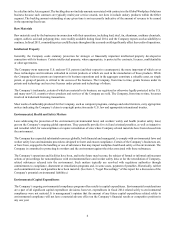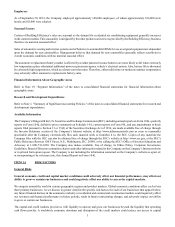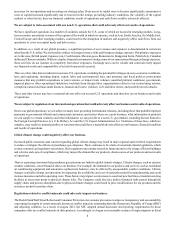Johnson Controls 2014 Annual Report Download - page 5
Download and view the complete annual report
Please find page 5 of the 2014 Johnson Controls annual report below. You can navigate through the pages in the report by either clicking on the pages listed below, or by using the keyword search tool below to find specific information within the annual report.5
Power Solutions
Power Solutions services both automotive OEMs and the battery aftermarket by providing energy storage technology, coupled
with systems engineering, marketing and service expertise. The Company is the largest producer of lead-acid automotive batteries
in the world, producing and distributing approximately 140 million lead-acid batteries annually in approximately 61 wholly- and
majority-owned manufacturing or assembly plants, distribution centers and sales offices in 22 countries worldwide. Investments
in new product and process technology have expanded product offerings to absorbent glass mat (AGM) and enhanced flooded
battery (EFB) technologies that power Start-Stop vehicles, as well as lithium-ion battery technology for certain hybrid and electric
vehicles. The business has also invested to develop sustainable lead and poly recycling operations in the North American and
European markets. Approximately 74% of unit sales worldwide in fiscal 2014 were to the automotive replacement market, with
the remaining sales to the OEM market.
Power Solutions accounted for 16% of the Company’s fiscal 2014 consolidated net sales. Batteries and key components are
manufactured at wholly- and majority-owned plants in North America, South America, Asia and Europe.
Competition
Building Efficiency
The Building Efficiency business conducts its operations through thousands of individual contracts that are either negotiated or
awarded on a competitive basis. Key factors in the award of contracts include system and service performance, quality, price,
design, reputation, technology, application engineering capability and construction or project management expertise. Competitors
for HVAC equipment and controls in the residential and non-residential marketplace include many regional, national and
international providers; larger competitors include Honeywell International, Inc.; Siemens Building Technologies, an operating
group of Siemens AG; Schneider Electric SA; Carrier Corporation, a subsidiary of United Technologies Corporation; Trane
Incorporated, a subsidiary of Ingersoll-Rand Company Limited; Daikin Industries, Ltd.; Lennox International, Inc.; GC Midea
Holding Co, Ltd. and Gree Electric Appliances, Inc. In addition to HVAC equipment, Building Efficiency competes in a highly
fragmented HVAC services market, which is dominated by local providers. The facilities management market, including Global
Workplace Solutions, is also fragmented at the local level with many regional companies servicing specific geographies. The
largest competition comes from ISS A/S; Sodexo SA and Jones Lang LaSalle, Inc. Sales of services are largely dependent upon
numerous individual contracts with commercial businesses worldwide. The loss of any individual contract would not have a
material adverse effect on the Company.
Automotive Experience
The Automotive Experience business faces competition from other automotive suppliers and, with respect to certain products,
from the automobile OEMs who produce or have the capability to produce certain products the business supplies. The automotive
supply industry competes on the basis of technology, quality, reliability of supply and price. Design, engineering and product
planning are increasingly important factors. Independent suppliers that represent the principal Automotive Experience competitors
include Lear Corporation, Faurecia SA and Magna International Inc.
Power Solutions
Power Solutions is the principal supplier of batteries to many of the largest merchants in the battery aftermarket, including Advance
Auto Parts, AutoZone, Robert Bosch GmbH, DAISA S.A., Costco, NAPA, O’Reilly/CSK, Interstate Battery System of America,
Sears, Roebuck & Co. and Wal-Mart stores. Automotive batteries are sold throughout the world under private labels and under the
Company’s brand names (Optima®, Varta®, LTH® and Heliar®) to automotive replacement battery retailers and distributors and
to automobile manufacturers as original equipment. The Power Solutions business competes with a number of major domestic
and international manufacturers and distributors of lead-acid batteries, as well as a large number of smaller, regional competitors.
The Power Solutions business primarily competes in the battery market with Exide Technologies, GS Yuasa Corporation, Camel
Group Company Limited, East Penn Manufacturing Company and Banner Batteries GB Limited. The North American, European
and Asian lead-acid battery markets are highly competitive. The manufacturers in these markets compete on price, quality, technical
innovation, service and warranty.
Backlog
The Company’s backlog relating to the Building Efficiency business is applicable to its sales of systems and services. At
September 30, 2014, the backlog was $4.8 billion, the majority of which relates to fiscal 2015. The backlog as of September 30,
2013 was $4.8 billion. The consistency in backlog year over year was primarily due to the increase in the Other segment, offset

